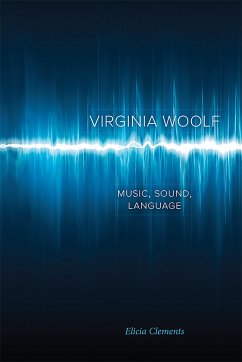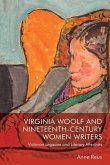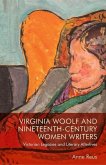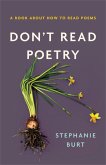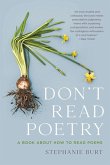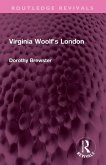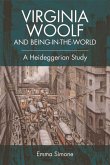- Gebundenes Buch
- Merkliste
- Auf die Merkliste
- Bewerten Bewerten
- Teilen
- Produkt teilen
- Produkterinnerung
- Produkterinnerung
This study investigates how the medium of sound and its most representative art form of music enable Virginia Woolf to develop fresh concepts and methods in her experimental fiction.
Andere Kunden interessierten sich auch für
![Virginia Woolf and Nineteenth-Century Women Writers Virginia Woolf and Nineteenth-Century Women Writers]() Anne ReusVirginia Woolf and Nineteenth-Century Women Writers26,99 €
Anne ReusVirginia Woolf and Nineteenth-Century Women Writers26,99 €![Virginia Woolf and Nineteenth-Century Women Writers Virginia Woolf and Nineteenth-Century Women Writers]() Anne ReusVirginia Woolf and Nineteenth-Century Women Writers138,99 €
Anne ReusVirginia Woolf and Nineteenth-Century Women Writers138,99 €![Virginia Woolf and Capitalism Virginia Woolf and Capitalism]() Virginia Woolf and Capitalism125,99 €
Virginia Woolf and Capitalism125,99 €![Don't Read Poetry Don't Read Poetry]() Stephanie BurtDon't Read Poetry23,99 €
Stephanie BurtDon't Read Poetry23,99 €![Don't Read Poetry Don't Read Poetry]() Stephanie BurtDon't Read Poetry23,99 €
Stephanie BurtDon't Read Poetry23,99 €![Virginia Woolf's London Virginia Woolf's London]() Dorothy BrewsterVirginia Woolf's London45,99 €
Dorothy BrewsterVirginia Woolf's London45,99 €![Virginia Woolf and Being-In-The-World Virginia Woolf and Being-In-The-World]() Emma SimoneVirginia Woolf and Being-In-The-World40,99 €
Emma SimoneVirginia Woolf and Being-In-The-World40,99 €-
-
-
This study investigates how the medium of sound and its most representative art form of music enable Virginia Woolf to develop fresh concepts and methods in her experimental fiction.
Produktdetails
- Produktdetails
- Verlag: University of Toronto Press
- Seitenzahl: 304
- Erscheinungstermin: 26. April 2019
- Englisch
- Abmessung: 236mm x 160mm x 25mm
- Gewicht: 628g
- ISBN-13: 9781487504267
- ISBN-10: 1487504268
- Artikelnr.: 51487046
- Herstellerkennzeichnung
- Libri GmbH
- Europaallee 1
- 36244 Bad Hersfeld
- gpsr@libri.de
- Verlag: University of Toronto Press
- Seitenzahl: 304
- Erscheinungstermin: 26. April 2019
- Englisch
- Abmessung: 236mm x 160mm x 25mm
- Gewicht: 628g
- ISBN-13: 9781487504267
- ISBN-10: 1487504268
- Artikelnr.: 51487046
- Herstellerkennzeichnung
- Libri GmbH
- Europaallee 1
- 36244 Bad Hersfeld
- gpsr@libri.de
By Elicia Clements
Acknowledgments
Abbreviations
Introduction
I. Woolf's Musical Ear
II. Interdisciplinary Methods
III. "Hoity te, hoity te, hoity te ...": Tripartite Woolf
Part 1 An Emerging Earcon: Woolf's Singers
1. Finding a Voice
I. Resonant Beginnings: The Voyage Out
II. Sonic Networks in Jacob's Room
III. Urban and Rural Interrelations in Mrs. Dalloway and To the Lighthouse
2. The Earcon Reproduces
I. "And what is a cry?": The Waves
II. Integrating the Earcon in The Years
III. Aural Multiplicity in Between the Acts
Part 2 Profound Listening and Acousmatics
3. Initial Apperceptions
I. Materialized Sonics and Listening Subjects in The Voyage Out
II. Involuntary, Yet Profound, Listening in Night and Day
III. International Acousmatics: War and Its Veterans in Jacob's Room and
Mrs. Dalloway
4. Bodies and Voices
I. To the Lighthouse and Family Acousmatics
II. The Gender of Listening in The Waves
III. "Hush!... Somebody's listening": The Years
IV. Heterogeneous Reattachments in Between the Acts
Part 3 Music as Performance in Woolf's Fiction
5. Performing Women
I. Women at the Piano in the First Three Novels
II. Performing Personal History in The Years
III. Historical Reenactments: Between the Acts
6. The Performativity of Language: The Waves Musicalized
I. Word Music: "(The rhythm is the main thing in writing)"
II. The Case of Ludwig van Beethoven
III. Transforming Beethoven's Opus 130 and 133 into Words
Coda: A Meditation on Rhythm
Notes
Works Cited
Index
Abbreviations
Introduction
I. Woolf's Musical Ear
II. Interdisciplinary Methods
III. "Hoity te, hoity te, hoity te ...": Tripartite Woolf
Part 1 An Emerging Earcon: Woolf's Singers
1. Finding a Voice
I. Resonant Beginnings: The Voyage Out
II. Sonic Networks in Jacob's Room
III. Urban and Rural Interrelations in Mrs. Dalloway and To the Lighthouse
2. The Earcon Reproduces
I. "And what is a cry?": The Waves
II. Integrating the Earcon in The Years
III. Aural Multiplicity in Between the Acts
Part 2 Profound Listening and Acousmatics
3. Initial Apperceptions
I. Materialized Sonics and Listening Subjects in The Voyage Out
II. Involuntary, Yet Profound, Listening in Night and Day
III. International Acousmatics: War and Its Veterans in Jacob's Room and
Mrs. Dalloway
4. Bodies and Voices
I. To the Lighthouse and Family Acousmatics
II. The Gender of Listening in The Waves
III. "Hush!... Somebody's listening": The Years
IV. Heterogeneous Reattachments in Between the Acts
Part 3 Music as Performance in Woolf's Fiction
5. Performing Women
I. Women at the Piano in the First Three Novels
II. Performing Personal History in The Years
III. Historical Reenactments: Between the Acts
6. The Performativity of Language: The Waves Musicalized
I. Word Music: "(The rhythm is the main thing in writing)"
II. The Case of Ludwig van Beethoven
III. Transforming Beethoven's Opus 130 and 133 into Words
Coda: A Meditation on Rhythm
Notes
Works Cited
Index
Acknowledgments
Abbreviations
Introduction
I. Woolf's Musical Ear
II. Interdisciplinary Methods
III. "Hoity te, hoity te, hoity te ...": Tripartite Woolf
Part 1 An Emerging Earcon: Woolf's Singers
1. Finding a Voice
I. Resonant Beginnings: The Voyage Out
II. Sonic Networks in Jacob's Room
III. Urban and Rural Interrelations in Mrs. Dalloway and To the Lighthouse
2. The Earcon Reproduces
I. "And what is a cry?": The Waves
II. Integrating the Earcon in The Years
III. Aural Multiplicity in Between the Acts
Part 2 Profound Listening and Acousmatics
3. Initial Apperceptions
I. Materialized Sonics and Listening Subjects in The Voyage Out
II. Involuntary, Yet Profound, Listening in Night and Day
III. International Acousmatics: War and Its Veterans in Jacob's Room and
Mrs. Dalloway
4. Bodies and Voices
I. To the Lighthouse and Family Acousmatics
II. The Gender of Listening in The Waves
III. "Hush!... Somebody's listening": The Years
IV. Heterogeneous Reattachments in Between the Acts
Part 3 Music as Performance in Woolf's Fiction
5. Performing Women
I. Women at the Piano in the First Three Novels
II. Performing Personal History in The Years
III. Historical Reenactments: Between the Acts
6. The Performativity of Language: The Waves Musicalized
I. Word Music: "(The rhythm is the main thing in writing)"
II. The Case of Ludwig van Beethoven
III. Transforming Beethoven's Opus 130 and 133 into Words
Coda: A Meditation on Rhythm
Notes
Works Cited
Index
Abbreviations
Introduction
I. Woolf's Musical Ear
II. Interdisciplinary Methods
III. "Hoity te, hoity te, hoity te ...": Tripartite Woolf
Part 1 An Emerging Earcon: Woolf's Singers
1. Finding a Voice
I. Resonant Beginnings: The Voyage Out
II. Sonic Networks in Jacob's Room
III. Urban and Rural Interrelations in Mrs. Dalloway and To the Lighthouse
2. The Earcon Reproduces
I. "And what is a cry?": The Waves
II. Integrating the Earcon in The Years
III. Aural Multiplicity in Between the Acts
Part 2 Profound Listening and Acousmatics
3. Initial Apperceptions
I. Materialized Sonics and Listening Subjects in The Voyage Out
II. Involuntary, Yet Profound, Listening in Night and Day
III. International Acousmatics: War and Its Veterans in Jacob's Room and
Mrs. Dalloway
4. Bodies and Voices
I. To the Lighthouse and Family Acousmatics
II. The Gender of Listening in The Waves
III. "Hush!... Somebody's listening": The Years
IV. Heterogeneous Reattachments in Between the Acts
Part 3 Music as Performance in Woolf's Fiction
5. Performing Women
I. Women at the Piano in the First Three Novels
II. Performing Personal History in The Years
III. Historical Reenactments: Between the Acts
6. The Performativity of Language: The Waves Musicalized
I. Word Music: "(The rhythm is the main thing in writing)"
II. The Case of Ludwig van Beethoven
III. Transforming Beethoven's Opus 130 and 133 into Words
Coda: A Meditation on Rhythm
Notes
Works Cited
Index

